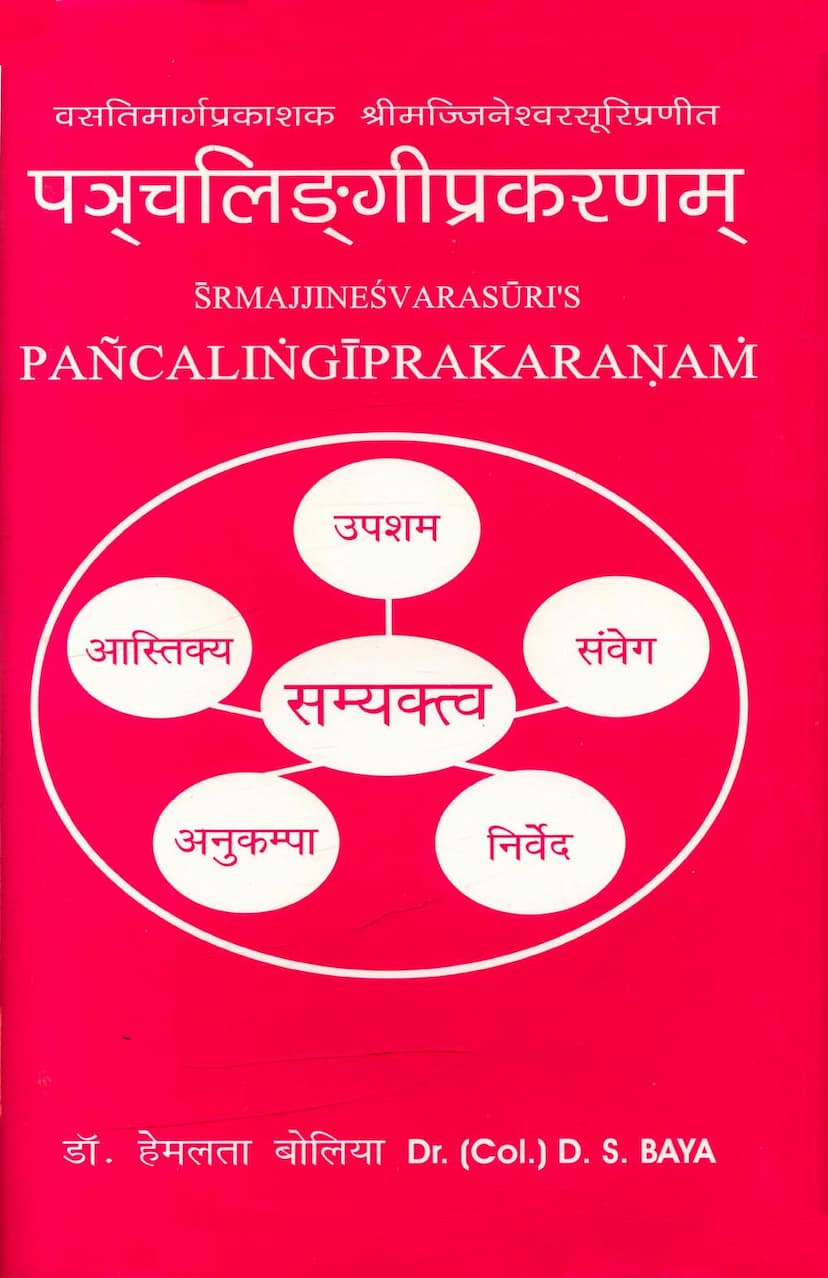Panchlingiprakaranam
Added to library: September 2, 2025

Summary
Here's a comprehensive summary of the Jain text "Panchlingiprakaranam" based on the provided pages:
Book Title: Panchlingiprakaranam Author: Shrimadjinesvarasuri Editors/Translators: Dr. Hemlata Boliya, Dr. (Col.) D. S. Baya Publisher: Shri Vimal Sudarshan Chandra Paramarthik Jain Trust
Core Subject Matter:
The Panchlingiprakaranam is a significant Prakrit poetic work by Acharya Shrimadjinesvarasuri, a prominent figure from the Khartar Gaccha lineage. The text meticulously elaborates on the five external indicators (lingas) of Samyaktva (Right Vision or Right Faith) in Jain philosophy. These five indicators are:
- Upsama (Subsidence): Primarily the subsidence of mithyābhineveśa (adherence to falsehood or insistence on meanings contrary to the teachings of the omniscient Jinas), not just the subsidence of passions.
- Samvega (Desire for Liberation): An intense longing to escape the cycle of suffering and achieve spiritual liberation.
- Nirveda (Detachment): A deep-seated aversion and disinterest towards worldly existence and its pleasures, stemming from an understanding of its inherent suffering and impermanence.
- Anukampā (Compassion): A compassionate disposition towards all living beings, especially the suffering, coupled with a desire and effort to alleviate their pain.
- Āstikya (Firm Belief): Steadfast and unwavering faith in the existence of the soul, the principles of Jainism, and the teachings of the Tirthankaras.
Key Themes and Content:
- The Importance of Samyaktva: The introduction (Aamukh/Preface) strongly emphasizes the paramount importance of Samyaktva as the foundational step on the path to liberation (Moksha). It is considered the root of Jainism, without which right knowledge and right conduct cannot be attained. The text quotes various ancient Jain scriptures highlighting Samyaktva's role in preventing sin, purifying the soul, and achieving ultimate salvation.
- Philosophical Comparison: The author also engages in a comparative study of Jain philosophical beliefs with other major Indian religious philosophies (Shad-darshanas), making the text a significant philosophical treatise.
- Detailed Elaboration of Each Linga: The book dedicates specific sections (verses) to each of the five indicators:
- Upsama: The text distinguishes between the subsidence of false belief and the subsidence of passions, arguing that the former is the true indicator of Samyaktva. It refutes the idea that passions alone signify right vision.
- Samvega: The desire for liberation is explained through the realization of the ultimately painful nature of sensual pleasures and the need to strive for the bliss of Moksha. The importance of virtuous conduct, even when complete detachment isn't immediately possible, is also discussed.
- Nirveda: This section delves into the suffering inherent in the beginningless cycle of birth and death (samsara), highlighting the miseries of various life forms (hellish, animal, human, and divine) to foster detachment from worldly existence.
- Anukampā: This part discusses the importance of compassion, particularly in the context of Jain practices like building temples and installing idols. It addresses the apparent violence involved in temple construction and argues that the ultimate benefit of leading beings towards liberation justifies it as an act of compassion. It also defines the limits of compassion for Jain monks, restricting them from engaging in or preaching activities that cause harm (like warfare, politics, or certain economic activities).
- Āstikya: This section focuses on establishing the existence of the soul and other Jain ontological categories (like non-living matter, influx, stoppage, bondage, separation, and liberation), refuting opposing philosophical views (like Buddhist momentariness and the Vedic concept of a common soul or a divine interventionist God). It underscores the importance of believing in the omniscient nature of Tirthankaras.
- Linguistic and Stylistic Aspects: The text is composed in Jaina Mahārāṣṭrī Prākrit in gāthā (verse) meter. The published edition includes Sanskrit commentaries and Hindi and English prose/poetry translations, making it accessible to a wider audience.
- Authorship and Historical Context: Shrimadjinesvarasuri, the author, was a key figure in establishing the Kharatara Gaccha, particularly after a significant debate in the 11th century CE. The work is believed to have been composed in the latter half of the 11th century CE.
- Collaborative Effort: The publication represents a significant effort by Dr. Hemlata Boliya (Sanskrit scholar) and Dr. (Col.) D. S. Baya (Prakrit and Jain philosophy scholar), with support from the Vimal Sudarshan Chandra Paramarthik Jain Trust and Shri Gujarati Jain Shwetambar Tapagaccha Sangh, Kolkata.
Overall Significance:
The Panchlingiprakaranam is a valuable contribution to Jain literature, providing a clear and insightful explanation of the five key indicators that demonstrate the presence of Right Vision, a crucial concept in the Jain path to spiritual liberation. Its comprehensive approach, including philosophical arguments and comparisons, makes it a vital text for both scholars and practitioners of Jainism. The translated edition bridges the gap between ancient Prakrit texts and modern readers, making the profound teachings of Jain philosophy more accessible.